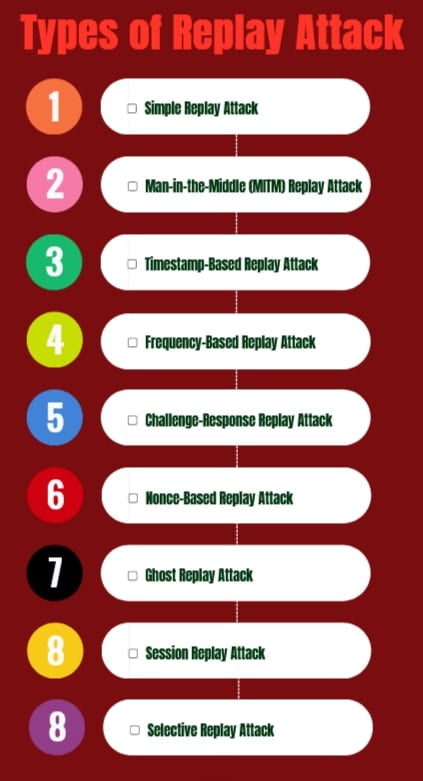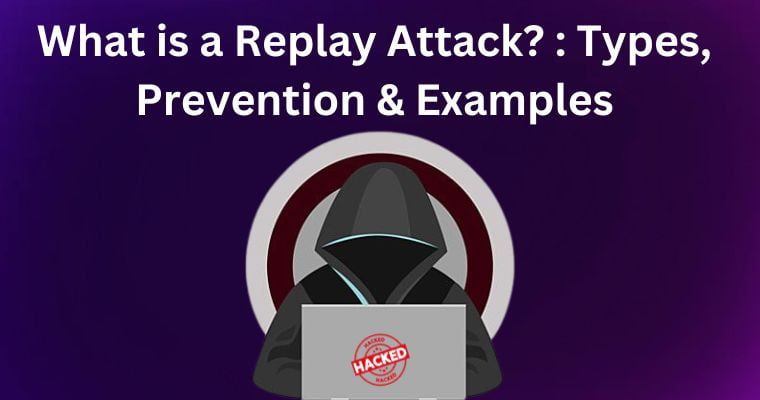In your place of work or your personal life, how many times do you connect with others? How many times have you sent an intensely confidential or private document?
It could be something as workwise serious as your business’s private bid for a tender or a document explaining your whole marketing policy for an upcoming quarter.
Now imagine if somebody who wasn’t supposed to see some of this gets access to it.
Consider that bad? Suppose that same somebody could change some information while it was being sent and ensure the intended destination received it.
In this circumstance, they could have altered the figures in the private official bid or changed the allocated budget for the advertising campaign.
This is what a replay attack seems like. The efficiency of such an attack depends on making both the sender & receiver think that the message was delivered perfectly while a huge change has been made.
By the time this change is noticed, the damage has possibly already been made.
So, if you’re concerned to learn more about what is a replay attack, how it works, some examples, and most significantly, how to prevent replay attacks, then read on.
Table of Contents
What is a Replay Attack?
A replay attack is a type of man-in-the-middle attack in which a hacker or user sniffs info being sent on a channel to interrupt them & resend them under the cloak of genuine messages.
What makes the replay attack mainly damaging is that the attacker does not even need to decrypt the note they resend but can still fool the person who receives it into thinking that the message is genuine.
In other words, think of this illegal party as having the capability to snoop on all your conversations, communication, & digital activity taking place through that specific channel. A Wi-Fi network for instance.
There are many implications of such an attack since it can render all your communications online susceptible.
More extremely, it will carry on to linger as a constant phantom within your prospect security protocols as there is no way to recognize for how long your communications have cooperated.
Is Replay Attack Active or Passive?
A replay attack can be either active or passive, depending on how it is executed.
Passive Replay Attack
In a passive replay attack, the attacker intercepts and records a communication or data exchange between two parties (e.g., a client and a server) without actively modifying the data.
Then, the attacker replays the recorded data at a later time to gain unauthorized access or perform malicious actions. Passive replay attacks do not alter the original data; they simply replay it as is.
Active Replay Attack
In an active replay attack, the attacker not only intercepts the data but also actively modifies it before replaying it. This can involve altering specific parts of the data to achieve malicious objectives.
Active replay attacks are typically more sophisticated and potentially more dangerous than passive ones because they involve manipulation of the intercepted data.
Types of Replay Attack

There are several types of replay attacks, which include the following:
Simple Replay Attack
In this type of attack, the attacker simply retransmits captured data or commands as they are. For example, if an attacker captures a login request, they may replay it to gain access to an account.
Man-in-the-Middle (MITM) Replay Attack
In an MITM replay attack, the attacker intercepts communication between two parties, captures data, and then retransmits it to the intended recipient. This can be used to eavesdrop on conversations or modify data in transit.
Timestamp-Based Replay Attack
To mitigate simple replay attacks, systems often use timestamps or sequence numbers to ensure that incoming data is current. However, attackers can still perform replay attacks if they capture and replay the entire message, including the timestamp.
Frequency-Based Replay Attack
In this variation, the attacker captures a legitimate message and replays it multiple times in quick succession. This can be used to flood a system with repeated requests, causing denial of service (DoS) or other disruptions.
Challenge-Response Replay Attack
Some authentication systems use challenge-response mechanisms to prevent replay attacks. In a challenge-response replay attack, the attacker captures the challenge and response and replays them later. This can potentially bypass authentication.
Nonce-Based Replay Attack
Nonces (random numbers or values used only once) are often employed to thwart replay attacks. However, if an attacker can capture both the nonce and the response, they may be able to replay the nonce and response pair to authenticate themselves.
Ghost Replay Attack
In this type of attack, the attacker captures data and retransmits it with slight modifications, such as changing a few bits in the message. This can confuse the receiving system, leading to unexpected behavior.
Session Replay Attack
Attackers can capture an entire session’s worth of data, including user interactions and authentication tokens, and then replay the entire session to impersonate the legitimate user.
Example: Online Banking Session Replay Attack
- User Logs In Alice logs in to her online banking account using her username and password. Upon successful authentication, the banking application creates a session for her, which includes a session token or identifier.
- Session Initialization: Once authenticated, the banking application generates a session token and associates it with Alice’s session. This token is used to validate subsequent requests from Alice and maintain her session state.
- Attacker’s Observation: An attacker, Eve, who has been monitoring Alice’s internet traffic, observes that Alice has successfully logged in to her online banking account. Eve captures the network traffic, including the session token, during Alice’s session.
- Logging Out: After completing her banking tasks, Alice logs out of her online banking account and closes the browser.
- Replay Attack: Later, Eve decides to launch a session replay attack. She uses the session token she captured earlier to impersonate Alice’s session. To do this, Eve sends the same session token in her own HTTP requests to the banking server.
- Unauthorized Access: The banking server, recognizing the session token as valid, allows Eve to access Alice’s account as if she were Alice herself. Eve can now view Alice’s account balance, make transactions, and perform any actions Alice could do during her session.
- Attack Goals: Eve can use this unauthorized access for various malicious purposes, such as transferring funds to her account, changing Alice’s account settings, or gathering sensitive information.
Selective Replay Attack
Instead of replaying an entire message, the attacker selectively replays certain portions of it to achieve their objectives. For instance, they might replay only the transaction amount in a financial transfer.
How Does a Replay Attack Work?
Take a look at this real-life attack situation. By sending encrypted info to the firm’s financial administrator, a corporate worker requests a fund transfer.
This communication is interrupted by an attacker, who captures it and might now resend it.
The communication is already properly encrypted & seems valid to the financial administrator since it is a reliable message that has simply been resent.
In this circumstance, unless the fiscal administrator has cause to be suspicious, he or she is possibly to react to the new request. A vast quantity of money might be sent to the attacker’s bank account as a reprisal.
Replay Attacks In Detail
Let us know replay attacks in detail with the benefit of a real-life example. Consider a business staff member asking for a monetary transaction from the company’s financial manager. He does so by sending an encoded message.
An attacker seeking a loophole to launch a replay attack might snoop on this message to satisfy his intention. His next step would be capturing the message so that he can resend it.
Now the message will look completely authentic because it has already been sent once. The financial administrator, who gets the message, will find it authentic as it has already been encoded.
What will occur now? In this case, the chances are that the fiscal administrator will reply to this new message unless there is a strong reason to get distrustful.
He will not distinguish between the two statements— the one he gets from the company’s staff fellow & the other he receives from the hacker.
The receiver, in this circumstance, the fiscal administrator, has received a similar message. It could lead to the fiscal administrator sending a heavy amount to the bank account of the attacker.
So, what the hacker did was crack the message from the network & decrypt it. He doesn’t even need to read or decipher the message. He just resends the update as it is.
The attacker used a humble technique or hack to break into the system & replay it simply by resending a message. It is how a replay attack in network safety works.
Examples of Replay Attacks
Suppose in the statement of two parties Tom and Bob; Tom is sending his key to Bob to verify his identity but in the meantime, Attacker Jake overhears the conversation between them & keeps the data which are required to verify his identity to Bob.
Later Jake contacts Bob and verifies its authenticity.
Except mitigated, networks and computers subject to replay attack would see the attack procedure as genuine messages.
One instance of a replay attack is to replay the note sent to a network by an attacker, which was formerly sent by a certified user.
Though the messages might be encrypted & the attacker might not get the real keys, and the retransmission of valid data or logon posts could help them gain adequate access to the network.
A replay attack can get access to the assets by replaying a verification message and can complicate the destination host.
One of the finest techniques to prevent replay attacks is by using strong digital signatures with timestamps.
An additional technique that could be used to evade a replay attack is by making random session keys that are time-bound and procedure-bound.
A one-time password for every request also helps in preventing replay attacks and is often used in banking operations.
Other methods used against replay attacks comprise sequencing of messages & non-acceptance of repeated messages.
What is a Replay Attack in Cryptography?
A replay attack in cryptography is a type of attack where an adversary intercepts and maliciously retransmits data that was previously recorded.
The goal of a replay attack is to impersonate the original sender or gain unauthorized access to a system by replaying legitimate data packets or messages. This attack can be particularly problematic in security-sensitive systems and communication protocols.
Data Capture
The attacker intercepts data packets or messages exchanged between two legitimate parties. This data can be in the form of network packets, authentication tokens, or any other type of communication.
Repetition
Instead of trying to decrypt or manipulate the intercepted data, the attacker simply resends the captured data as is, often multiple times.
Target System
The target system, which may include a server, device, or network, receives the repeated data and processes it, assuming it’s legitimate because it appears to be from the original sender.
Unauthorized Access
Depending on the context, the replayed data could lead to unauthorized access, financial fraud, unauthorized transactions, or other malicious activities.
Cryptographic and Security Protocols to Mitigate Replay Attacks
Timestamps
Including timestamps in messages or data packets to ensure that they are only considered valid for a specific duration. If a message is received with an expired timestamp, it is rejected.
Nonces (Number Once)
Including nonces, which are unique values used only once, in each message. The recipient keeps track of nonces it has seen before and rejects any messages with duplicate nonces.
Sequence Numbers
Assigning sequence numbers to messages or packets and ensuring that they are processed in the correct order. If a message arrives with an out-of-sequence number, it is discarded.
Cryptographic Authentication
Using cryptographic techniques such as digital signatures or message authentication codes (MACs) to ensure the integrity and authenticity of the data. This makes it difficult for attackers to modify or replay messages without detection.
Session Tokens
In some cases, session-specific tokens or keys are generated for each session and are not reusable in subsequent sessions.
What is a Replay Attack in Network Security?
A replay attack in network security is a type of cyberattack where an attacker intercepts and then maliciously retransmits data that was previously recorded.
The goal of a replay attack is to gain unauthorized access to a system or impersonate a legitimate user by replaying the captured data.
This type of attack can be particularly harmful when sensitive information such as authentication tokens or encrypted messages is involved. It can have serious consequences, particularly in financial systems, authentication processes, and sensitive communication networks.
Implementing mechanisms in the network or application layer to detect and reject replayed messages based on timestamps, sequence numbers, or other attributes.
Encrypting data can make it harder for attackers to capture and replay sensitive information.
Organizations need to implement robust security measures to detect and prevent these types of attacks.
How to Prevent Replay Attacks?
We recognize that replay attacks can lead to dire penalties. So, the real query is, how can we protect ourselves from replay attacks?
The main way to stop these attacks is to attach timestamps or order numbers to every sent message. This will let the receiver discard some messages with a repeated timestamp or order number.
An additional prevention technique is to utilize digital signatures to make it simpler for the receiver to validate if the sender is the individual they think they are.
Replay attacks can also be minimalized with the help of random-session session keys, which are time-specific & will change with time making it hard for an attacker to fool the receiver with an earlier message.
As replay attacks are contingent on reusing the session authorizations that an attacker has intercepted, stopping replay attacks frequently means generating a single-use encryption key or ID for an Internet session.
Several network transmissions between two users now use a particular, single-use encryption key, which is simply valid for one session and will not let an attacker replay the session.
Users might even log into an account with a single-use passcode, which will have to be reset for every successive login. This stops a replay attacker from submitting one more request with the intercepted password; it will no longer be functional.
A virtual private network can protect users from man-in-the-middle attacks: they set up a computer network distinct from the normal network, which normally prevents attackers from stealing the Internet connection.
But, VPNs are not flawless, and they’ve sometimes allowed attackers to gain the user’s network through endpoint insecurities.
Certain VPNs have flaws that let attackers replay Internet sessions, having gained access to their network link using cookies that weren’t dealt with correctly.
If you are using a VPN to evade replay attacks, research different options cautiously & watch for security bugs that have come to light in specific VPN products.
Standard Techniques in Replay Attacks
The predictable techniques in replay attacks are listed below.
Kerberos prevention technique: Throughout protocol exchanges between the user & the server, Kerberos implements a time authenticator. It also drafts the ticket’s lifetime and, most significantly, the user’s timestamp.
The message will be excluded if the authenticator’s timestamp isn’t within 5 minutes of the server’s time. This is because the extreme duration that might be accepted between users & servers is five minutes. But, the timing can be different.
One-time passwords (OTP): A password or secret code that can simply be used once for a transaction. With the user’s OTP program, the verification server operates on similar authorizations in OTP-based safety features.
The use of OTP is based on the indication that every OTP is valid for 10 minutes or one effective activation, depending on which comes first.
Sequencing: Authentic messages are numbered, & the receiver will reject accept packages, not in the right order. As a result, inner delay or duplication attacks are stopped.
Random session key: The session key allows both parties to have protected & closed-end transactions using time-bound & process-bound code.





